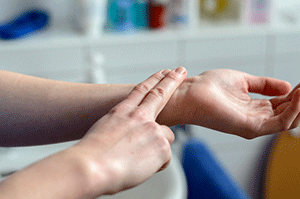In the United States, the National Institute on Drug Abuse (NIDA) publishes that there were 10,684 fatal benzodiazepine overdoses in 2016. Benzodiazepines are some of the most widely prescribed psychiatric drugs that are designed to treat anxiety and panic disorders, insomnia, seizure disorders, and muscle tension.
The five most regularly prescribed benzodiazepines, or benzos, in the U.S. include Valium (diazepam), Klonopin (clonazepam), Ativan (lorazepam), Restoril (temazepam), and Xanax (alprazolam), per the Drug Enforcement Administration (DEA). These are also the five most commonly misused benzos and those most often found diverted from licit sources.
How Benzos Work
Benzodiazepines are sedative-hypnotic tranquilizer medications that suppress the central nervous system and reduce respiration, heart rate, blood pressure, and body temperature by interacting with levels of GABA (gamma-Aminobutyric acid) in the brain. GABA helps to promote relaxation by lowering anxiety, tension, and stress, and reducing overactive nerve firings that can occur in the case of panic, anxiety, seizure, and sleep disorders.
When taken as directed, these medications are considered to be safe and effective for the short-term management of the indicated symptoms. Benzos are commonly misused, however, which occurs when they are taken in higher doses than prescribed, in between doses, after a prescription runs out, in ways other than intended (snorting, smoking, or injecting them instead of swallowing the tablets), without a medically necessary prescription.
The National Survey on Drug Use and Health (NSDUH) publishes that more than 2.5 million Americans misused a prescription sedative or tranquilizer medication in 2016. Abuse of benzos greatly increases the risk for a toxic interaction, or overdose, as the dosage is higher than intended.
A benzodiazepine overdose is considered a medical emergency. You should call 911 immediately if one is suspected.
Recognizing a Benzo Overdose
Benzos are depressant substances, which means that intoxication is often similar to that of being drunk with alcohol. A person may appear uncoordinated, slur their speech, be drowsy, fall, appear sluggish, and struggle to think clearly, remember things correctly, or make coherent decisions.
A benzodiazepine overdose can lower autonomic and life-sustaining functions to dangerous levels and can be life-threatening. If any of the following signs are recognized after taking benzos, seek urgent medical attention and professional help:
Signs of a Benzo Overdose
- Problems breathing or shallow breathing
- Mental confusion
- Lowered blood pressure
- Slow or weak pulse
- Cold, clammy skin
- Bluish-looking lips, skin, or nails
- Extreme drowsiness
- Loss of consciousness
- Impaired coordination
- Muscle weakness
- Blurred vision
- Diminished reflexes
- Coma
The journal Critical Care Medicine reports that alprazolam is commonly recognized in benzodiazepine overdoses, and it may be more toxic than other benzos. Alprazolam is short-acting benzo. The prescribing information for Xanax warns that overdose deaths from alprazolam have been reported, both due to alprazolam alone and in combination with alcohol.
A toxic dosage of alprazolam is typically much higher than the recommended dose (more than 195 mg/kg, or milligram per kilogram, in animal experiments), which is 975 times the human recommended maximum daily dose of 10 mg/kg. Typically, overdoses involving benzodiazepines also include other central nervous system depressant substances, such as alcohol or opioid drugs.
The U.S. Food and Drug Administration (FDA) places its highest warning on opioid pain medications, opioid cough suppressants, and benzodiazepines, highlighting the dangers of mixing these medications. Using more than one depressant substance at the same time increases the rate of respiratory depression and can more quickly lead to overdose and cause death.
Opioid overdose is a public health crisis in the United States today. NIDA explains that about a third of all opioid overdose fatalities involve a benzodiazepine drug as well.
In addition to mixing alcohol or opioids with benzos, the way the medication is taken can also increase the risk for overdose. If tablets that are meant to be swallowed are crushed and snorted, injected, or smoked, the entire dosage is sent into the bloodstream at once.
 Instead of being metabolized through the digestive system, the drug is rapidly sent across the blood-brain barrier.
Instead of being metabolized through the digestive system, the drug is rapidly sent across the blood-brain barrier.
This is especially dangerous if the benzo being misused in this manner is a long-acting or extended-release medication that is meant to be dispensed into the bloodstream slowly or in a time-released fashion.
According to Stat Pearls, intravenous (IV) and intramuscular (IM) injectable formulations of diazepam and lorazepam carry an additional overdose risk due to the enhanced odds for propylene glycol toxicity when taken in high amounts.
This is related to the diluent used in these medication formulations. Seizures, organ failure, skin necrosis, and blood pressure, and heart rate irregularities are signs of propylene glycol toxicity.
Benzodiazepine overdose can also be influenced by age, sex, race, and other biological factors that can increase the risk for an adverse reaction and more dangerous consequences.
What To Do in the Event of a Benzo Overdose
The first thing to do if a benzo overdose is suspected is call 911. Give the operator as much information as you have, including:
Information To Give 911
The more information you can share with the responding professionals, the better. While waiting for the paramedics to arrive, try to keep the person calm and awake if possible. If they are lying down, put them in the recovery position (on their side in the fetal position with their head turned to the side) to help keep their airway open and unobstructed.
- The person’s age and approximate weight
- What they took
- How they took it and how much they took
- Whether or not they have a prescription for the medication
- If they suffer from any medical or mental health conditions
Once help arrives, let medical personnel know how long the person has been in this state if the person lost consciousness at any point, and as many details, as you have about the individual, the drugs are taken, and symptoms you have observed. Even things that may seem insignificant can help to save a life.
Benzo overdose is often reversed with the use of flumazenil, but the interaction of this medication may lead to seizures. At times, supportive medical care may be the best option until the process of the drug out of the body.
Again, a benzo overdose may be reversible with swift medical attention, so do not hesitate to call for help.

